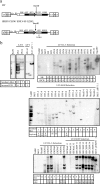Insertional gene activation by lentiviral and gammaretroviral vectors
- PMID: 18945765
- PMCID: PMC2612344
- DOI: 10.1128/JVI.01865-08
Insertional gene activation by lentiviral and gammaretroviral vectors
Abstract
Gammaretroviral and lentiviral vectors are promising tools for gene therapy, but they can be oncogenic. The development of safer vectors depends on a quantitative assay for insertional mutagenesis. Here we report a rapid, inexpensive, and reproducible assay which uses a murine cell line to measure the frequency of interleukin-3 (IL-3)-independent mutants. Lentiviral and gammaretroviral vectors cause insertional mutagenesis at similar frequencies; however, they use different mechanisms. Human immunodeficiency virus (HIV)-based vectors generate mutants by insertion only into the growth hormone receptor (Ghr) locus. The HIV enhancer/promoter is active in the absence of the HIV Tat protein in this locus, and an HIV/Ghr spliced transcript expresses GHR and cells respond to GH. Deletion of the enhancer/promoter in a self-inactivating HIV-based vector prevents this mechanism of insertional mutagenesis. In contrast, gammaretroviral vectors insert into other loci, including IL-3 and genes identified as common insertion sites in the Retroviral Tagged Cancer Gene Database (RTCGD).
Figures




Similar articles
-
Insertional transformation of hematopoietic cells by self-inactivating lentiviral and gammaretroviral vectors.Mol Ther. 2009 Nov;17(11):1919-28. doi: 10.1038/mt.2009.179. Epub 2009 Aug 11. Mol Ther. 2009. PMID: 19672245 Free PMC article.
-
Safer, silencing-resistant lentiviral vectors: optimization of the ubiquitous chromatin-opening element through elimination of aberrant splicing.J Virol. 2012 Sep;86(17):9088-95. doi: 10.1128/JVI.00485-12. Epub 2012 Jun 13. J Virol. 2012. PMID: 22696657 Free PMC article.
-
Equal potency of gammaretroviral and lentiviral SIN vectors for expression of O6-methylguanine-DNA methyltransferase in hematopoietic cells.Mol Ther. 2006 Feb;13(2):391-400. doi: 10.1016/j.ymthe.2005.08.012. Epub 2005 Oct 12. Mol Ther. 2006. PMID: 16226060
-
Biosafety challenges for use of lentiviral vectors in gene therapy.Curr Gene Ther. 2013 Dec;13(6):453-68. doi: 10.2174/15665232113136660006. Curr Gene Ther. 2013. PMID: 24195603 Review.
-
Foamy virus vectors: an awaited alternative to gammaretro- and lentiviral vectors.Curr Gene Ther. 2007 Aug;7(4):261-71. doi: 10.2174/156652307781369092. Curr Gene Ther. 2007. PMID: 17969559 Review.
Cited by
-
Therapeutic Consequences of Targeting the IGF-1/PI3K/AKT/FOXO3 Axis in Sarcopenia: A Narrative Review.Cells. 2023 Dec 7;12(24):2787. doi: 10.3390/cells12242787. Cells. 2023. PMID: 38132107 Free PMC article. Review.
-
Insertional transformation of hematopoietic cells by self-inactivating lentiviral and gammaretroviral vectors.Mol Ther. 2009 Nov;17(11):1919-28. doi: 10.1038/mt.2009.179. Epub 2009 Aug 11. Mol Ther. 2009. PMID: 19672245 Free PMC article.
-
Development of non-viral vehicles for targeted gene transfer into microglia via the integrin receptor CD11b.Front Mol Neurosci. 2014 Oct 9;7:79. doi: 10.3389/fnmol.2014.00079. eCollection 2014. Front Mol Neurosci. 2014. PMID: 25346658 Free PMC article.
-
Nonintegrating lentivector vaccines stimulate prolonged T-cell and antibody responses and are effective in tumor therapy.J Virol. 2009 Apr;83(7):3094-103. doi: 10.1128/JVI.02519-08. Epub 2009 Jan 28. J Virol. 2009. PMID: 19176629 Free PMC article.
-
Lentivector cryptic splicing mediates increase in CD34+ clones expressing truncated HMGA2 in human X-linked severe combined immunodeficiency.Nat Commun. 2022 Jun 28;13(1):3710. doi: 10.1038/s41467-022-31344-x. Nat Commun. 2022. PMID: 35764638 Free PMC article. Clinical Trial.
References
-
- Aiuti, A., S. Slavin, M. Aker, F. Ficara, S. Deola, A. Mortellaro, S. Morecki, G. Andolfi, A. Tabucchi, F. Carlucci, E. Marinello, F. Cattaneo, S. Vai, P. Servida, R. Miniero, M. G. Roncarolo, and C. Bordignon. 2002. Correction of ADA-SCID by stem cell gene therapy combined with nonmyeloablative conditioning. Science 2962410-2413. - PubMed
-
- Baixeras, E., S. Jeay, P. A. Kelly, and M. C. Postel-Vinay. 2001. The proliferative and antiapoptotic actions of growth hormone and insulin-like growth factor-1 are mediated through distinct signaling pathways in the Pro-B Ba/F3 cell line. Endocrinology 1422968-2977. - PubMed
Publication types
MeSH terms
Grants and funding
LinkOut - more resources
Full Text Sources
Other Literature Sources
Medical

